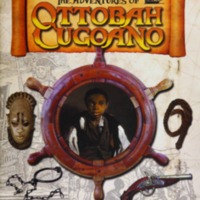
The Adventures of Ottobah Cugoano
The Adventures of Ottobah Cugoano is a book written for young readers, written by Marcia Hutchinson and Pete Tidy, and published by Primary Colours as part of the Freedom and Culture 2007 initiative. Ottobah Cugoanao was an African abolitionist, captured in 1770 in Fante (present-day Ghana) and sold into slavery. He was eventually made free and baptized John Stuart in London. Stuart became active in Sons in Africa and through his publications campaigned for abolition. A Key Stage 2 and Key Stage 3 Teaching Pack was produced to accompany the adventure story, written by Marcia Hutchinson, Pete Tidy and Shazia Azhar, with a foreword by David Lammy MP.
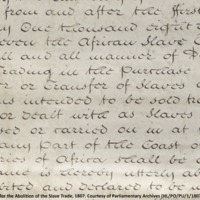
Young Runaway Slaves
An exhibition at the Victoria and Albert Museum of Childhood in London focused on the experiences of young runaway slaves in Britain. The exhibition focused in particular on the story of Ignatius Sancho, born in 1729 on board a slave ship, who ran away from his owners in Greenwich. Sancho's letters, later published, became an inspiration for those who campaigned for abolition.
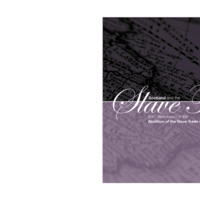
Scotland and the Slave Trade
The official publication to mark the bicentenary from One Scotland, the Scottish Executive.
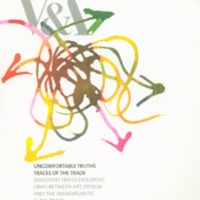
Uncomfortable Truths
Uncomfortable Truths at the Victoria and Albert Museum sought to expose how embedded the transatlantic slave trade was within British culture during the 18th and 19th centuries through art and design. A series of five trails - 'Traces of the Trade' - explored the permanent collections on display through the following themes: Consuming the Black Atlantic, Black Servants in British Homes, Britain and the West Indies, Representing Slavery and Abolitionism, Gold and Slaves Transnational Trade Links. An exhibition of contemporary art examined the impact of the legacies of slavery on modern art and design. The Victoria and Albert Museum commissioned new works by Yinka Shonibare, Romauld Hazoume, Julien Sinzogan and Keith Piper. These and other contemporary interventions by a total of 11 artists were displayed throughout the museum. This exhibition later toured to Ferens Art Gallery in Hull.
The 'Truth and Rights' season of events highlighted often untold stories of Black British heroes, including focus on the actor Ira Aldridge. Visitors were also offered discussions, debates, displays and an eight week free art course. A two-day conference, 'From Cane Field to Tea Cup: The Impact of the Transatlantic Slave Trade on Art and Design' focused on V&A collections took place in February 2007.
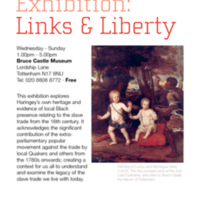
Links and Liberty
An exhibition at Bruce Castle Museum (in partnership with Euroart Studios) explored the transatlantic slave trade, Haringey's heritage relating to the trade and its legacy, and the historic Black presence in the borough from the 16th century onwards. There was a particular focus on the painting of Lucius and Montague Hare, sons of Lord Coleraine (former owner of Bruce Castle), with their African servant. The exhibition also looked at the extra-parliamentary popular movement against the trade by local Quakers such as Priscilla Wakefield and others. Contemporary dance workshops for secondary schools were led by dance company Movement Angol.
The Links and Liberty exhibition included 'Stolen', a life-size installation by artists at Euroart Studios (John Fowler, Lorraine Clarke and Nigel Young) of a section of a slave ship. School pupils were encouraged to climb inside to imagine conditions on board.
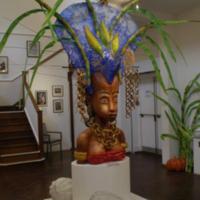
Parallel Views: Black History in Richmond
The Parallel Views exhibition and its associated community engagement programme explored the relevance of the bicentenary for communities in the London Borough of Richmond upon Thames, uncovering local associations with slavery and its abolition. It also told the parallel story of twin town Richmond, Virginia, USA, to broaden understanding of the transatlantic slave trade and the impact of its demise. The exhibition examined evidence of individuals of African origin who had come to Richmond, and residents with financial links to slavery and the slave trade, and to abolitionism. A film piece by choreographer and dance historian Dr Rodreguez King-Dorset explored the use of dance within the free Black community in London during the era of abolition. A display of contemporary artwork responded to the ideas of the exhibition. A sculpture by carnival artist Carl Gabriel linked consumers in Richmond and the conditions of production of slave-grown crops. The design was inspired by a series of workshops with local families. Artist-led workshops for children and young people led to the creation of a carnival costume piece which was included in the exhibition.
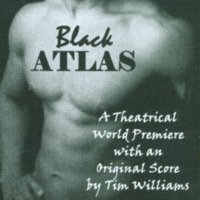
Black Atlas
A performance by the London Shakespeare Workout based on George MacDonald Fraser's novel 'Black Ajax'. The play, set in Regency England, tells the historical tale of two enslaved men through dialogue, song and verse. One slave is from America, another is from Africa. The former, Tom Molineaux, becomes the first Black Prize Fighter in Britain. Black Atlas featured an original score by Tim Williams. The play opened in Cambridge and toured to 40 different venues around the UK.
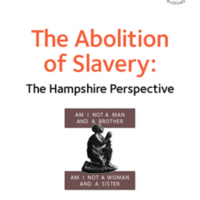
The Abolition of Slavery: The Hampshire Perspective
A touring exhibition exploring Hampshire's links with slave ownership and the abolition campaign was produced by (and featured material from) Hampshire Museums and Archives Service and Hampshire Record Office. The exhibition was on show in the Record Office foyer, before travelling to museums, schools and community centres around the county. The exhibition revealed that there were slave owners living in places in Hampshire such as the village of Hurstbourne Tarrant, and told the story of a slave-trading voyage in 1700 led and financed by men from the Titchfield area. Black servants, very likely former slaves, could be found in unlikely places such as Martyr Worthy and Bramdean. The abolition campaign was fought in the columns of the Hampshire Chronicle and the Hampshire Telegraph, and communities as diverse as Portsmouth, Whitchurch and Fordingbridge sent in petitions to Parliament on the subject. The exhibition also mentioned white slaves taken from the English coast by Barbary pirates, and the testimony of a group of emancipated slaves from Cuba who arrived in Southampton in 1855 on their way to Lucomi in Africa.
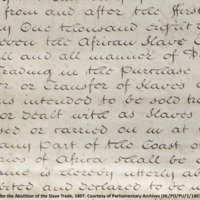
Guernsey and the Slave Trade
A display in the entrance foyer of Guernsey Museum in 2007 explored the island's connections with slavery and the slave trade. Relevant items from the museum's collection included a slave collar and chain from a slaver intercepted by a Guernsey captain on anti-slavery patrols, and a 17th-century portrait of Anne de Beauvoir and a slave child. Guernsey was involved in the transatlantic slave trade via islanders directly involved in the traffic (for example, Thomas Ebworthy of the ship 'Anne Galley'); ships known to be involved, such as the 'African' and the 'Fanny'; and islanders' involvement with the supply of goods or services.
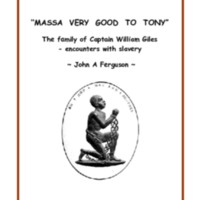
“Massa Very Good to Tony” The family of Captain William Giles - encounters with slavery
A lecture given to the Cumbria Family History Society Annual Conference in November 2007 was produced in booklet form and deposited in the Cumbria Record Office at Carlisle. To mark the bicentenary, John A. Ferguson researched the story of a former slave from Jamaica who lived in Cumberland. Captain William Giles of the British Army served in the West Indies in the 1780s, settling with his family in Jamaica. When the family returned to England, they brought with them James Anthony, known as "Tony", their former domestic slave. Tony was later servant to several other families in Carlisle, and is buried in St Mary's churchyard.
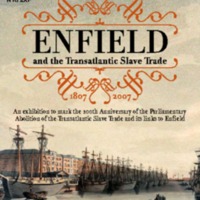
Enfield and the Transatlantic Slave Trade
An exhibition to mark the bicentenary was developed by Enfield Museum Service in partnership with the British Museum and Enfield Racial Equality Council. The exhibition looked at West African culture, the development of the local African community, the links between the transatlantic slave trade and Enfield, wealthy landowners and Quaker abolitionists who lived in the area. Free family days held during school vacations offered traditional Ghanaian story-telling, dancing and drumming, crafts and object handling. Living History Days gave visitors the opportunity to meet actors portraying William Wilberforce and Olaudah Equiano. School workshops included a drama session and performance about a runaway slave developed from material from Lambeth Archive. The museum service also produced a book, edited by Valerie Munday, which explored further the links between Enfield and the slave trade. The book was sent to all schools in the borough, and formed the basis of a teaching resource aimed at Key Stages 2 and 3. Loan boxes and handling collections provided by the museum service include Ghanaian artefacts and items relating to the slave trade. In 2011, Enfield Racial Equality Council unveiled a plaque to commemorate abolition at the Enfield Civic Centre.
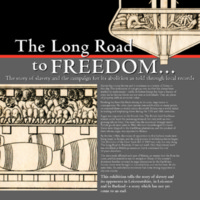
The Long Road to Freedom
As made clear by The Long Road to Freedom exhibition in 2007, the Record Office for Leicestershire, Leicester & Rutland contains a significant collection of documents which reveal local connections with the slave trade, and with those who campaigned for abolition. Several prominent local families owned slaves on plantations in the Caribbean and on the north coast of South America. Leading Leicester abolitionists, Elizabeth Heyrick and Susanna Watts, orchestrated a vigorous anti-slavery campaign in Leicester, including a boycott on sugar. Local landowner, Thomas Babington of Rothley Temple, was a friend of William Wilberforce and hosted meetings of anti-slavery campaigners at his home. The exhibition also highlighted a unique collection of mid-19th century papers which provide access to the voices of the enslaved in a slave court in Lagos, West Africa. It also told the stories of two former slaves, Rasselas Morjan and Edward Juba, who came to Leicestershire with their owners. This exhibition toured to various venues in the region, including Abbey Pumping Station, where it coincided with family activities focused on the work of Elizabeth Heyrick.
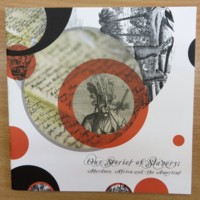
Our Stories of Slavery: Aberdeen, Africa and the Americas
The Our Stories of Slavery events programme ran from May to October 2007, co-ordinated by the Arts Development team at Aberdeen City Council. The project examined all aspects of Aberdeen's links with slavery and the transatlantic slave trade, including the role of Aberdonian landowners as slave owners, as well as the impact of Aberdonians as abolitionists, such as the roles played by James Beattie and James Ramsay.
One focus of the project was on the role of Aberdonian magistrates in kidnapping children from the City and Shire and selling them into indentured service to plantation owners during the 18th century. Peter Williamson, known as 'Indian Peter', was one of up to 700 kidnapped in Aberdeen between 1735 and 1750. The project used his story, with archives at the University of Aberdeen, in a range of activities including storytelling, re-enactments, film making, workshops, creative writing and craft workshops. Kidnapped was a re-enactment set in and around The Tolbooth (Aberdeen's Museum of Civic History). In collaboration with artist Chris Biddlecombe, community knitting circles created 'Cast-offs', exhibited at Aberdeen's Kirk of St Nicholas, whereby an installation of 600 knitted jumpers represented the abducted children.
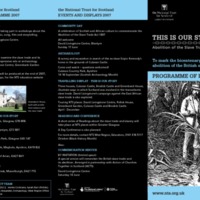
This is Our Story
To mark the bicentenary, the National Trust for Scotland put together a wide-ranging programme of events to engage their audiences with Scottish connections to slavery and abolition. Three National Trust for Scotland properties in the West of Scotland – Culzean Castle, Brodrick Castle and Greenbank House – illustrate the ways in which Scotland was involved in the transatlantic slave trade. A touring exhibition based on this new research was shown at these sites and others in the West of Scotland. The Beckford Collection of furniture, silver and China at Brodrick Castle, on the Isle of Arran, once belonged to William Beckford, owner of several sugar plantations in the West Indies. Scipio Kennedy from ‘Guinea’ lived at Culzean Castle, Ayrshire, from 1710, first as a slave and then as a paid servant. The Allason brothers of Greenbank House were traders in tobacco and slaves. David Livingstone spent much of his life campaigning against the slave trade based in East Africa. His work is remembered at the David Livingstone Centre in Blantyre.
The 2007 Learning Programme involved workshops for local community groups and a resource pack for teachers and youth leaders. Events included a celebration of Scottish and African culture at the David Livingstone Centre; a survey and excavation in search of the ex-slave Scipio Kennedy’s home in the grounds of Culzean Castle; and a Commemoration Service arranged in partnership with Action of Churches Together in Scotland (ACTS).
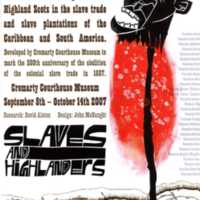
Slaves and Highlanders
An exhibition developed by Cromarty Courthouse Museum in the Scottish Highlands recording the role of Highland Scots in the slave trade and slave plantations of the Caribbean and South America and, in particular, British Guiana. The striking illustrations were by John McNaught. The exhibition told individual stories of Scottish merchants, plantation owners and their slaves, such as a slave called Inverness, bought, sold, exploited and hunted as a runaway by Scots in Demerara. It also looked at the freed slaves who found a place in Scottish society. Connected to this project was the placing of a plaque in the former Royal Northern Infirmary (now the executive office of the University of the Highlands and Islands). It remains one of the few acknowledgements of the use of profits from the slave plantations to fund charitable public institutions, and the only known one in Gaelic.
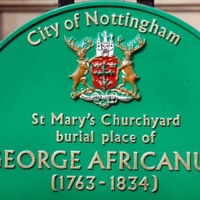
Rededication service for George Africanus
George John Scipio Africanus (1763-1834) was Nottingham's first recorded black entrepreneur, starting an employment agency called the 'Africanus Register of Servants'. As a child, Africanus was brought to England from Sierra Leone and given as a present to wealthy Wolverhampton businessman Benjamin Molineux. He then moved to Nottingham and became a freeholder. Nottinghamshire Archives and MLA East Midlands produced web resources for teachers and learners based on the life of George Africanus. An exhibition toured venues around the city, including Nottingham Council House and Brewhouse Yard. On 25 March 2007, as part of the bicentenary events in Nottingham, a service was held at St Mary's Church led by the Bishop of Kingston (Jamaica), the Rt Revd Robert Thompson. A new memorial stone was dedicated to Africanus, and a plaque unveiled commemorating his life.
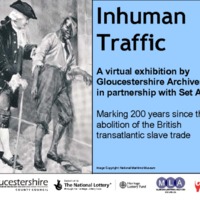
Inhuman Traffic
The Inhuman Traffic project was led by Gloucestershire Archives, in partnership with the Set All Free initiative. The virtual exhibition and accompanying web resource were based on documents held at Gloucestershire Archives and, in particular, the papers of the anti-slavery campaigner Granville Sharp (1735-1813). The exhibition explored topics such as the contribution of black people to the abolition movement, aspects of the legacies of slavery, including racism and domestic violence. Over 400 copies of the exhibition DVD were sent to schools, churches, tourist information venues and individuals across Gloucestershire. The associated programme of events included performances of the play 'Inhuman Traffic', developed in collaboration with a local theatre company, Spaniel in the Works. The play features four interacting characters with different perspectives on slavery. A cross-curricular teaching resource was later developed, which included a second performance, 'Master and Slave', in partnership with Stroud District Museums Service, Spaniel in the Works, and Parliament Primary School, Stroud.
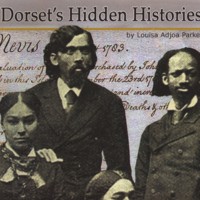
Dorset's Hidden Histories
DEED (Development Education in Dorset) works within the community to develop understanding of global education and cultural diversity. The charity produced and made available to hire the Dorset's Hidden Histories touring exhibition, which explored 400 years of the stories of people with African and Caribbean heritage across Dorset, Bournemouth and Poole. Many Dorset families were involved in slavery, either owning or trading in African slaves, and Black people were brought to Dorset by slave traders to live as servants in the large country houses. The exhibition, which is still available to borrow, also includes details of African American GIs on Poole Quay, a freed enslaved American living in Bournemouth, and Belle Davis, the African-American singer and dancer who performed in Weymouth in 1917. The organisation worked with Louisa Adjoa Parker, a local poet and black history researcher, to provide creative writing workshops to explore the exhibition. An accompanying booklet, written by Parker, can be purchased from DEED.
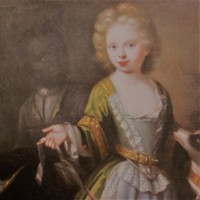
Revealed: Luxury Goods and the Slave Trade
Remembering Slavery 2007 was a regional initiative involving museums, galleries and other cultural organisations across the North East of England in a programme of exhibitions, events, performances, lectures and activities to explore the themes of slavery and abolition.
As part of the initiative, the Bowes Museum in Barnard Castle exhibited art objects from its collection, which traced the European demand for luxury goods linked to the system of plantation slavery, such as tobacco, sugar and indigo. For example, the exhibition included a number of sugar moulds and designs, alongside tobacco graters and tins. The recently conserved 'Girl with a Dog' by Philip Vilain (c. 1708) was also on display; the painting features a black servant faded into the background, revealing of eighteenth-century British society's racial divisions.
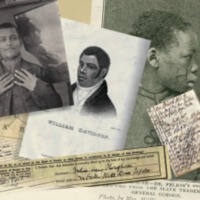
History Detectives: Black People in the West Midlands 1650-1918
SCAWDI are a Birmingham based community group specialising in working with local volunteers to research the early presence of Black people in the West Midlands and learn more about their local history. Different projects sought to explore this heritage. ‘In the beginning …’ looked at enslaved Africans who came to the West Midlands to live with wealthy land owners in the area’s stately homes. ‘History Detectives’ took this work further to identify and construct biographies for the black individuals who came to the West Midlands before 1918. The project created a database of almost 200 individuals: the characters explored connect to themes of slavery, class, migration and religion. ‘A day in the life …’ created a black heritage trail detailing the locations attached to these stories.